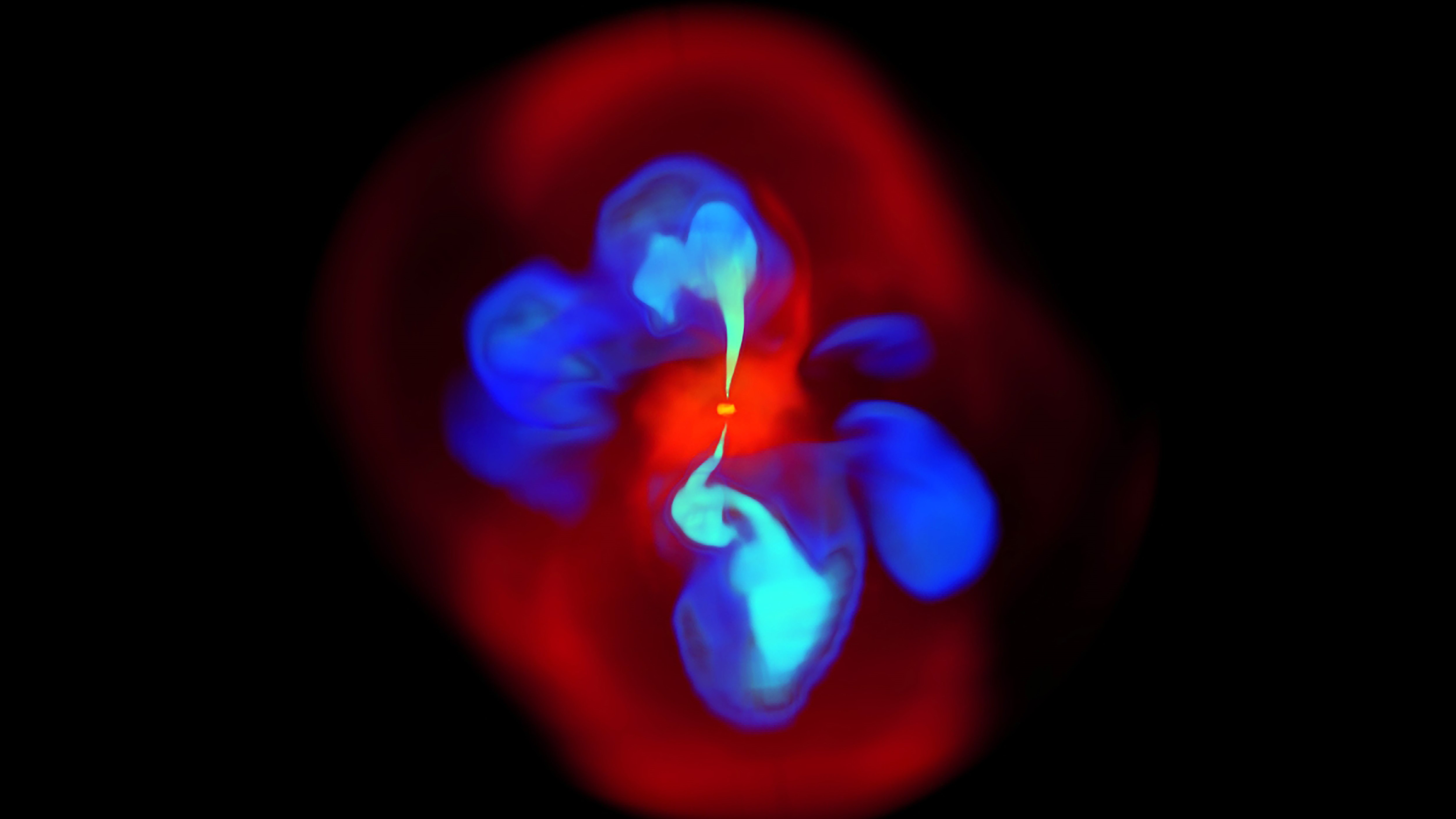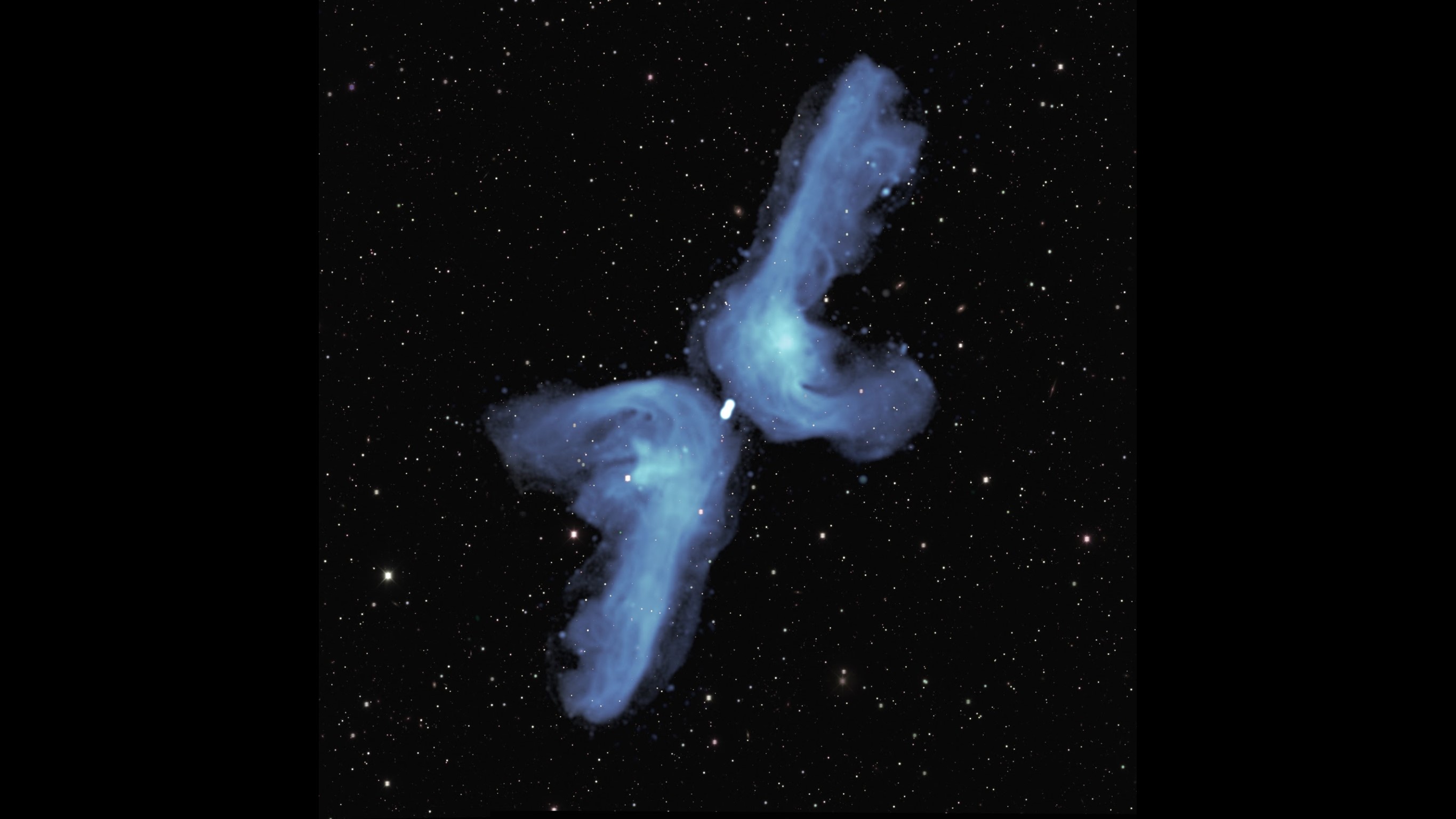Rare X-shaped radio galaxies shaped by feeding supermassive black holes
Galaxies marked by four jets extending deep into space may form more simply than previously thought.
A team of astrophysicists may have finally solved the mystery of what creates rarely-seen radio-bright X-shaped galaxies.
A sophisticated simulation has shown that these galaxies, which are distinguished by four massive jets of material that shoot into space, could result from a process much simpler than scientists previously thought. The simulation shows that the shape can form from the interaction between hot gas falling into the galaxy's supermassive black hole and the near light-speed jets of material it blasts out.
If correct, the model could also suggest that X-shaped radio galaxies are more common than currently believed, but are short-lived and lose their distinctive X-shaped jets, so astronomers simply haven't been fortunate enough to spot a wealth of galaxies in this fleeting stage.
Related: Why are galaxies different shapes?

The new simulation was run by astrophysicists at Northwestern University in Illinois and is the first large-scale simulation to track galactic gas as it moves a great distance to fall into the titanic object's surface. In the model, the researchers applied simple conditions to a model of a supermassive black hole consuming gas from a surrounding thin disk of matter, which scientists call an accretion disk. And that simulation showed that simple conditions organically and unexpectedly led to the formation of an X-shaped radio galaxy.
"We found that even with simple symmetric initial conditions, you can have quite a messy result," Aretaios Lalakos, lead author on the paper and a graduate student in Northwestern's department of physics and astronomy, said in a statement.
The simulation showed that the characteristic X shape of these galaxies arose when infalling gas deflects jets launched by the supermassive black hole. The jets themselves switched on and off during the early stage of the simulation and also erratically 'wobbled.' This early erratic behavior inflated pairs of gaps or cavities in the gas pointed in different directions, creating an X shape.
Get the Space.com Newsletter
Breaking space news, the latest updates on rocket launches, skywatching events and more!

When the jets grew strong enough to push through the infalling gas, however, they stabilized, ceased wobbling, and merged into a single jet along one axis of the black hole.
This mechanism would replace what has been the popular explanation for the creation of X-shaped radio galaxies, the collision of galaxies. "Two galaxies collide, causing their supermassive black holes to merge, which changes the spin of the remnant black hole and the direction of the jet," Lalakos said, describing that scenario. Scientists had also posited that the shape stemmed from the interaction between the jet and the large cloud of gas surrounding a supermassive black hole.
"Now, we have revealed, for the first time, that X-shaped radio galaxies can, in fact, be formed in a much simpler way," Lalakos said.
'X' marks the spot of a surprise discovery
The discovery of this avenue to X-shaped galaxy birth surprised Lalakos, who began the simulation to see how much matter supermassive black holes could consume. It was Northwestern astrophysicist Sasha Tchekovskoy who noticed the significance of the picture as it emerged from the simulation.
"He [Tchekovskoy] said, 'Dude, this is very important! This is an X-shape!' He told me that astronomers have observed this in real life and didn't know how they formed," Lalakos said. "We created it in a way that no one had even speculated before."
Lalakos suspects that the key to the success of this simulation, and the reason it hit upon a previously unseen phenomenon, is its simplicity, as well as the fact that it didn't dictate gas symmetrically surrounding the supermassive black hole.
"Usually, researchers put a black hole in the middle of a simulation grid and place a large, already-formed gaseous disk around it, and then they may add ambient gas outside the disk," Lalakos said. "In my simulation, I tried to assume nothing."
Lalakos explained that in his team's simulation, the black hole begins without a surrounding disk of gas, which instead forms when as already-rotating gas approaches the black hole. Gas from this disk then flows into the black hole, creating the jets that soon begin wobbling.
"I made the simplest assumptions possible, so the whole outcome was a surprise," he said. "This is the first time anyone has seen X-shaped morphology in simulations from very simple initial conditions."
Such simple formation might mean that X-shaped radio galaxies are common but short-lived, potentially explaining why these galaxies account for just 10% of radio galaxies spotted by astronomers.
"They might arise every time the black hole gets new gas and starts eating again," Lalakos said. "So they might be happening frequently, but we might not be lucky enough to see them because they only happen for as long as the power of the jet is too weak to push the gas away."
Lalakos will further investigate this potential formation model by experimenting with parameters in the simulation such as the size of the accretion disk and the spin of the central supermassive black hole.
Sophisticated simulations are crucial in investigations such as this because of the difficulty involved in observing black holes, particularly new ones, Lalakos said. "For most of the universe, it's impossible to zoom in right at the center and see what's happening very near a black hole," he said.
"And even the things we can observe, we are constrained by time. If the supermassive black hole is already formed, we cannot observe its evolution because the human lifetime is too short," he added. "In most cases, we rely on simulations to understand what happens near a black hole."
The team's results are presented in a paper to be published in the journal Astrophysical Journal Letters on Monday (Aug. 29).
Follow us on Twitter @Spacedotcom and on Facebook.
Join our Space Forums to keep talking space on the latest missions, night sky and more! And if you have a news tip, correction or comment, let us know at: community@space.com.

Robert Lea is a science journalist in the U.K. whose articles have been published in Physics World, New Scientist, Astronomy Magazine, All About Space, Newsweek and ZME Science. He also writes about science communication for Elsevier and the European Journal of Physics. Rob holds a bachelor of science degree in physics and astronomy from the U.K.’s Open University. Follow him on Twitter @sciencef1rst.









